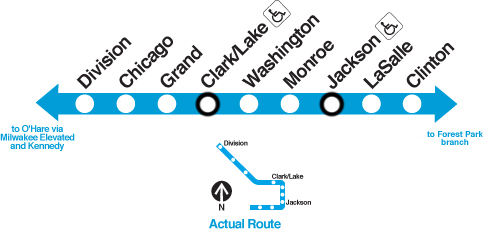|
|
|
|
.
Blue Line:
Milwaukee-Dearborn Subway
 |
||||||||||
|
Legend:
Click on a station name to see that station's profile (where available) |
|
|
|
|
.
Blue Line:
Milwaukee-Dearborn Subway
 |
||||||||||
|
Legend:
Click on a station name to see that station's profile (where available) |
Service Notes:
| Hours of Operation: Service at all times | ||
| Length of Route: 4.12 miles | ||
Number of Stations: 9 stations |
||
| Car Types Assigned: 2600-series, 3200-series, 5000-series*, 7000-series (see Car Assignment sheet for latest car assignments) | ||
| * 5000-series cars assigned to 54th Yard, run lite to Blue Line for rush period trips | ||
Brief Description:
Two subway lines included in the Initial System of Subways plan, the State Street Subway and Milwaukee-Dearborn Subway, were designed to accommodate crosstown routes through downtown. The Milwaukee-Dearborn tubes would give the Logan Square branch a more direct route to downtown, entering from the northwest rather than the more circuitous approach from the southwest via the old Metropolitan main line.
Federal dollars made available by President Franklin Delano Roosevelt's New Deal programs during the Great Depression made the construction of the subways possible, allowing Chicago to carry out a civic improvement it'd long planned for but been able to get off the ground. Work in the Milwaukee-Dearborn tubes began in March 1939. Chicago built its subways using the deep bore method. Each subway line has two tubes, one per track in each direction, each dug with its own boring shield twenty-five feet in diameter. Each tunnel was then backed up with continuous steel liner plates and ribs, reinforced with steel bars, and covered with concrete. The only sections constructed by the "cut-and-cover" method were the station mezzanines, crossovers between the tunnels, and short distances just before the subway portals as the tubes ascend to ground level to connect to the elevated.
While the subway was under construction, world events took a critical turn. Completion of the stations was delayed by a materials shortage due to rationing for World War II. Subway Route No. 2 (Milwaukee-Dearborn), which was 80% complete in 1942, was mothballed after the war began due to wartime labor and materials rationing, but Route No. 1 (State Street) was classified as an essential wartime transportation link for defense plant workers and was allowed to continue.
The City would not return to work on the Dearborn Subway for several years, leaving the partially completed tubes mothballed under the city streets. Finally, in late 1945, work resumed on the subway when the city advertised for bids to build the hand-mined western leg of the route.
The Milwaukee-Dearborn Subway officially opened for revenue service after midnight on February 25, 1951 when a train driven by motorman Wallace Hurford left Logan Square at 12:05am and would be the first to be diverted into the new subway rather than via the old Metropolitan Northwest branch.
Your New Blue: O'Hare Branch Track, Station and Other Improvements
On December 5, 2013, Mayor Rahm Emanuel and Governor Pat Quinn announced a comprehensive improvement plan for the Blue Line O'Hare Branch (including the northern portion of the Dearborn Subway), an overhaul that will provide faster travel times and updated stations while creating more than 1,300 jobs.
The $492 million plan, called Your New Blue, includes several track and station improvement projects along a 12.5-mile stretch of the Blue Line between the Grand and Cumberland stations, as well as upgrades to the signal system between the Jefferson Park and O'Hare stations.
The project, beginning construction in 2014 and planned to last four years, is a package of several discrete projects ranging from station improvements to track renewal, signal replacement, traction power upgrades, and subway tunnel water mitigation efforts. Most of the projects are along the formal O'Hare branch segment northwest of the Dearborn Subway -- on the Milwaukee Elevated, on the Kennedy Extension, and on the O'Hare Extension -- but a few projects will take place in the Dearborn Subway:
The track renewal builds upon the work done in the Dearborn Subway in 2007-08 and on the O'Hare Branch between Addison and O'Hare in 2008. With the track work planned under the Your New Blue project, all of the track between O'Hare and Downtown, though the Halsted Portal, will have been renewed.
These improvements are intended to provide faster, more comfortable and more reliable commutes for the more than 80,000 customers who each weekday use stations along the branch, which had 25 million rides in 2012. Ridership on the O'Hare Branch was growing rapidly, with more than 25 million station entries in 2012. Weekday ridership grew 25 percent over the previous five years since 2013, and 33 percent over the previous 10 years, outpacing the growth of the rail system as a whole. The stations receiving the most significant upgrades have experienced some of the biggest ridership jumps on the O'Hare branch.
Funding for Your New Blue is expected to come from local, state and federal sources.
Important Dates:
|
|
This Chicago-L.org article is a stub. It will be expanded in the future as resources allow. |
.
|
|